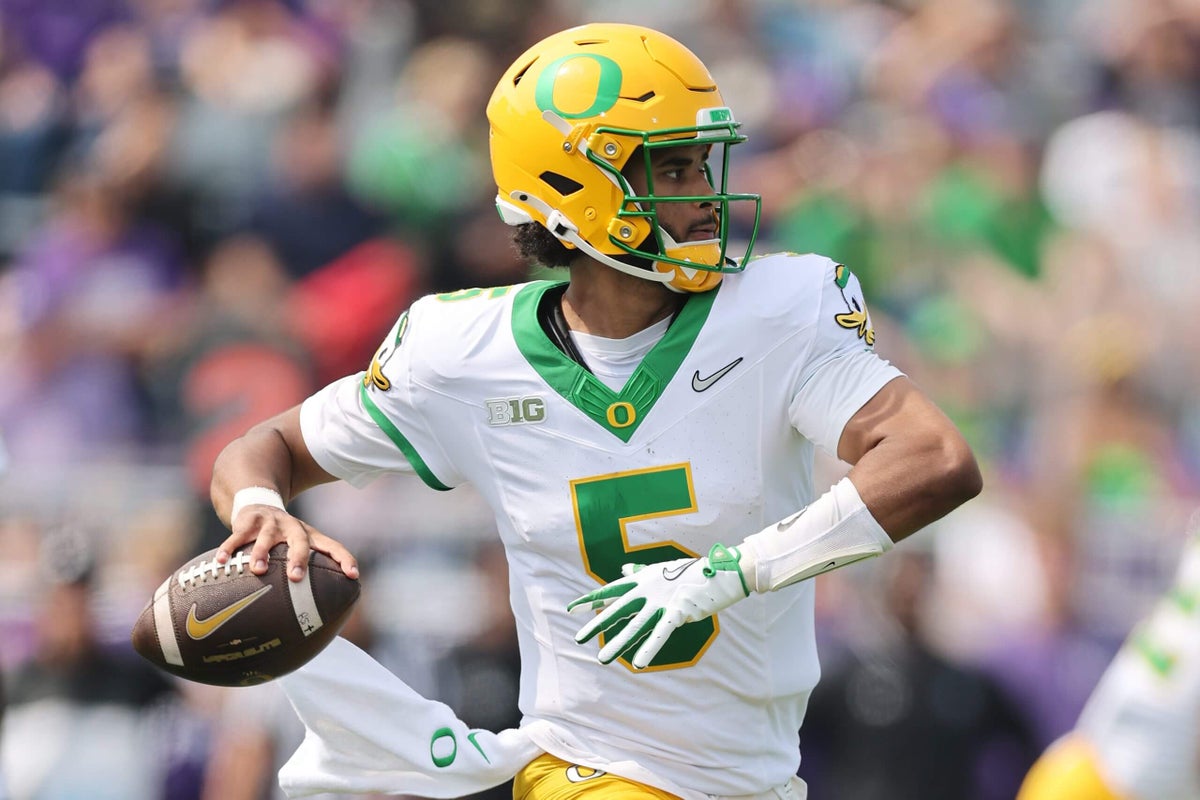It doesn’t matter if we’re talking coaching, competing or even parenting — there is no substitute for experience.
And that is especially true for quarterbacks.
Bill Parcells famously believed college quarterbacks needed a minimum of 30 starts before reaching the NFL. Drew Brees thinks it requires 50 “high-quality” starts to be ready. No matter where you land on an exact number, the issue of experience — or a lack thereof — could make any evaluations of the 2026 NFL Draft QB class that much trickier.
Take Alabama’s Ty Simpson and Oregon’s Dante Moore. They’re two of the best draft-eligible quarterback prospects in college football, but neither will have a robust resume should they make the NFL jump after this season. Hypothetically, let’s project that Simpson and Moore both start 14 games this season before going pro. That total would give Simpson 14 career starts (zero over his first three years at Alabama) and Moore 19 career starts (including five at UCLA as a true freshman).
Two other potential members of the 2026 draft class, South Carolina’s LaNorris Sellers and Garrett Nussmeier (20 career starts each), are in a similar range. Further up the ladder is Fernando Mendoza, who already had 19 college starts to his credit before transferring to Indiana this year, and could close in on 35 career starts should the Hoosiers make a deep playoff run.
I asked an NFL director of scouting for his perspective on how much college experience means for a QB’s pro success.
“I would equate it to arm strength,” he said. “It’d be great if a quarterback has a monster arm like Josh (Allen) or (Matthew) Stafford. But it’s more about reaching a certain threshold. Having the strongest arm isn’t the same as saying (someone has) the best arm. It’s the same with experience — the more, the better. But it’s more about having ‘enough.’”
How would those potential 2026 draft prospects’ projected start totals compare to the college experience of current NFL quarterbacks? Fifty-two NFL QBs have started at least one game in 2025 and/or were first-round picks within the last decade. Here’s a look at the top half of that list, in order of college starts made:
Other names of note include Dak Prescott and Caleb Williams (33 starts each), Jordan Love (32), Patrick Mahomes (29), Bryce Young (27) and Josh Allen (25).
Ten quarterbacks in the group made fewer than 25 college starts: Sam Darnold (24), Tua Tagovailoa (24), Carson Wentz (23), Justin Fields (22), Mac Jones (17), Trey Lance (17), Kyler Murray (17), Dwayne Haskins (14), Anthony Richardson (13) and Mitchell Trubisky (13). Darnold is the only one among them playing at an above-average level, but he is on his fifth team and required development over his first seven NFL seasons to reach this level.
I don’t want to paint with too broad a brush, because some young quarterbacks are failed by a lack of development once in the league (a point emphasized by the NFL scouting director who spoke to The Athletic for this piece, as well). However, generally, the more a quarterback starts in college, the more he is exposed to countless examples of situational football or better develops an understanding of defensive tendencies and read adjustments.
The layers of evaluating the QB position are endless, but experience and maturity clearly matter.
The context of each situation is different, of course — and no less important. After three years as a starter at Arizona State, Jayden Daniels considered going pro and likely would have been a Day 3 pick. Who knows if he’d be starting in the NFL had he left college at that point. Instead, he transferred to LSU, added 26 more starts to his college resume and further developed into the quarterback we know today. Baker Mayfield made 46 starts in college and had immediate success as a rookie with the Browns, but he also needed his struggles in Cleveland, Carolina and Los Angeles to help him find success in Tampa Bay.
Realistically, there isn’t a magic number of starts QB prospects must reach, especially given the vast differences in competition levels from conference to conference in today’s college football landscape. Still, in general, data backs up common sense: The more starts, the better.
This is more about contextualizing the debate on college starts rather than taking a hard stance on Simpson’s or Moore’s (or Sellers’, Nussmeier’s and Mendoza’s) potential as NFL quarterbacks. We will have plenty of time for that if, or when, they declare. And it is also important to point out that those quarterbacks, in particular, are on different timelines — Simpson will turn 23 in December, while Moore won’t be 21 until after the upcoming draft.
Each quarterback’s journey is unique. A lack of experience on the resumes of quarterbacks such as Simpson and Moore isn’t ideal, but it’s also not necessarily an automatic disqualifier.

